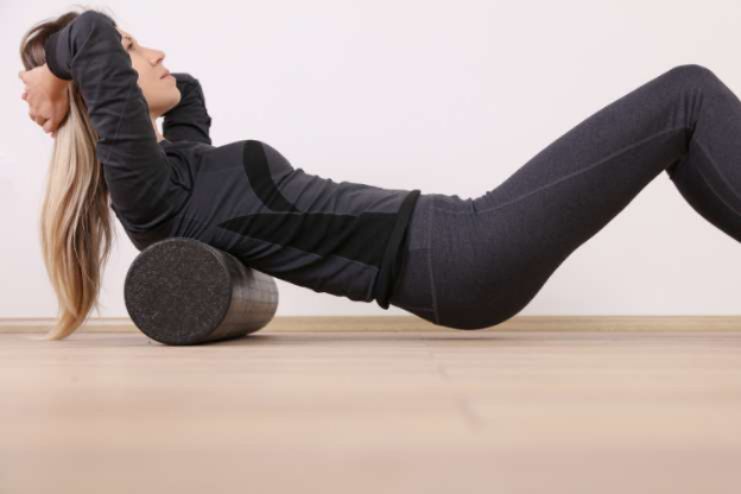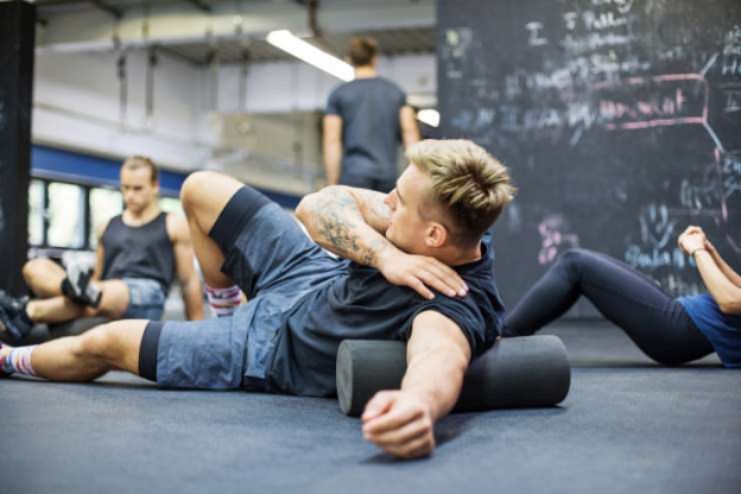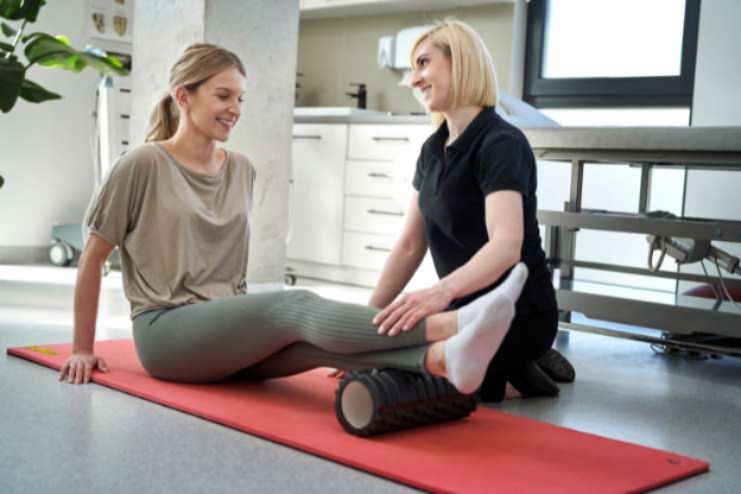Affiliate Disclaimer
Some links in this article are affiliate links. We may earn a small commission if you make a purchase through these links, at no extra cost to you. We only recommend products we find useful to our readersFoam rolling has gained popularity in the fitness industry and is now the preferred recovery technique for gym-goers and athletes. By applying pressure to tense or injured muscles using a foam roller, this self-myofascial release technique promises increased mobility and a quicker recovery.
Is foam rolling merely another fitness fad, or does it aid recovery?
Supporters assert that it increases flexibility, reduces muscular soreness, and speeds up the healing process following vigorous activity. However, some argue that there is conflicting scientific data and wonder if foam rolling is better for athletes to heal than alternative options.
What is the truth, then? To help you get the most out of your post-workout recovery regimen, let’s examine the science behind foam rolling, its advantages, and typical errors.
Read More: Why You’re Not Seeing Results from Your Workouts (And How to Fix It)
How Foam Rolling Works
Numerous bodily components, such as organs, nerves, and muscle tissues, are surrounded and bound by fascia, a connective tissue. Increasingly, gym and physiotherapy clinic equipment used to treat related issues has led to a broader understanding of the myofascial fascia surrounding muscle tissue. It covers issues like injury, poor tissue health, and overuse.
Foam rollers and other self-myofascial release devices have gained popularity recently as ways to improve exercise performance and recuperation. Foam rolling makes sense as a corrective workout technique since it is simple to use, feels “good,” and appears to be effective. It also has a great cost-benefit ratio.
According to one systematic study, foam rolling may be a helpful method for enhancing joint range of motion and performance both before and after exercise.
Using a high-quality foam roller is more than just a pleasant experience; it is like a deep tissue massage. For various reasons, including self-myofascial release, it’s essential to anyone’s pre- and post-workout regimens.
Most trainers advise foam rolling before a workout. Research in Medicine & Science in Sports & Exercise found that rolling after an intense workout can reduce pain over the next two days, while another study in The Journal of Strength & Conditioning Research indicated that rolling out for just one minute can increase your range of motion.
The following are the most targeted areas:
Quads: If your desk job keeps you sedentary most of the day, work out your quadriceps to get your blood flowing and keep your muscles active. Place the roller beneath your quadriceps and begin in a forearm plank position. Roll down the roller carefully until it barely touches your knees, bracing yourself with your upper body and core. After that, roll the other way until you reach your hip flexors.
Calves: For an added bounce in your stride, consider foam rolling your calves in addition to stretching them. Sit on the floor with your legs outstretched and the foam roller beneath your calves. Raise your body, fold your right calf back, and cross your left leg over your right.
Read More: Active Recovery: Why Rest Days Don’t Have to Mean Doing Nothing
Foam Rolling and Muscle Recovery: What Research Says

Today, athletes of all skill levels employ foam rolling (FR). It’s unclear if FR works better as a cool-down for recuperation or as a warm-up to improve performance.
Foam rolling nearly always feels fantastic, much like a sports massage. As with massage, foam rolling works better at some times than others. After working out, using a foam roller can help relieve acute discomfort, but what about delayed onset muscle soreness (DOMS)?
Its potential to prevent DOMS, or soreness that begins a day or two after a workout, is not well studied.
Although the poor clinical study findings may surprise, foam rolling is unlikely to produce effects comparable to those of a licensed professional therapist.
Researchers used search engines to conduct a thorough and organized literature search. Twenty-one studies satisfied the requirements for inclusion. Seven research studies used post-rolling, while fourteen used pre-rolling. While pre-rolling had no impact on jump and strength performance, it did slightly improve sprint and flexibility performance.
Post-rolling somewhat reduced the declines in strength and sprint performance brought on by exercise. While its impact on jump performance was negligible, it also decreased the impression of muscle soreness.
Who Can Benefit from Foam Rolling?

One of those things that almost everybody can use to their advantage is foam rolling. It’s a fantastic method to reduce tightness and increase mobility for regular people. Additionally, foam rolling can be a game-changer for healing if you’re interested in fitness, regardless of how long you’ve been going to the gym.
According to a 2024 study published in the Journal of Bodywork and Movement Therapies, rolling for a short while after working out can reduce delayed-onset muscle soreness or pain the day after a hard workout.
It’s also excellent for senior citizens. As we age, our fascia becomes less moisturized and tighter, which might impair movement. Foam rolling is a good technique to keep things supple and preserve a range of motion as we age.
Athletes, weightlifters, and runners who strain their muscles during training may also benefit from foam rolling. Frequent foam rolling helps relieve tightness and pain, reducing the range of motion these people frequently suffer. It facilitates increased restoration, less muscle tension, and increased flexibility, all boosting performance in upcoming exercises or competitions.
Additionally, when it comes to serious illnesses, it cannot replace professional therapies like massage or physical therapy. If you’re experiencing severe soreness, chronic pain, or an injury, it’s wise to consult a physical therapist first. Getting the go-ahead from an expert is always preferable for safety.
Read More: Top 10 Essential Strength Training Equipment for Home Workouts
How to Foam Roll Correctly

Many people form a love/hate connection with their foam roller. Working through the discomfort that comes with rolling out knots may improve your range of motion and shorten the time it takes to recover from an intense activity.
When first learning to use a foam roller, it’s best to be overly soft rather than too intense because using one can be uncomfortable. You can modify the intensity as you become more aware of how your body reacts.
To utilize your foam roller, take the following actions:
Identify the muscle that is tight or sore.
Slowly lower the targeted area until it is centered over the roller while maintaining body control.
When you feel uncomfortable but not in agony, lower your body onto the foam roller and hold it there.
Hold for 20–30 seconds.
In addition to the benefits of the pressure, you can further stimulate the area by slowly rolling back and forth.
Continue using the roller to travel slowly along the muscle, pausing and holding in the places that require greater attention.
Try adjusting your body position while using your foam roller to determine the best method. Don’t forget to breathe. Many people even forget to breathe because they are so focused on the sensation of rubbing a severe knot.
Shop Now: Try a soft foam roller if you are a beginner.
Shop Now: For intense muscle relief, try a firm foam roller!
Read More: 7 Signs You’re Overtraining and How to Avoid It
Final Thoughts
Athletes and fitness fanatics swear by foam rolling as a popular rehabilitation technique. It is well known to increase general mobility, decrease muscular soreness, and improve flexibility. By exerting pressure on the muscles, the technique can help loosen tense areas and increase blood flow, which speeds up recovery.
Many people find foam rolling helpful for releasing muscle tension and avoiding stiffness, especially after vigorous workouts. However, not everyone may see noticeable improvements. Whether you’re an athlete or someone trying to increase your mobility, it’s an easy-to-use tool that you can implement into your regimen.
The proper technique can supplement other recovery techniques like stretching and rest, and it’s an inexpensive and efficient way to help with recovery.
References
- https://www.lesmills.com/us/fit-planet/fitness/foam-rolling/
- https://complete-physio.co.uk/foam-rollers/
- https://www.menshealth.com/fitness/a19515618/truth-about-foam-rolling/
- https://journals.lww.com/nsca-jscr/fulltext/2013/03000/an_acute_bout_of_self_myofascial_release_increases.34.aspx
- https://www.runnersworld.com/health-injuries/a20806059/the-truth-about-foam-rolling/
- https://pubmed.ncbi.nlm.nih.gov/24343353/
- https://www.healthline.com/health/fitness-exercise/foam-rolling-how-to#If-you-re-a-foam-rolling-newbie-don-t-worry-here-s-how-to-do-it
- https://health.clevelandclinic.org/foam-rolling
- https://www.runnersworld.com/health-injuries/a33076172/heres-what-research-says-is-the-best-way-to-foam-roll/
- https://www.sciencedirect.com/science/article/abs/pii/S136085921930395X
- https://pmc.ncbi.nlm.nih.gov/articles/PMC6465761/
- https://www.drgraeme.com/articles/2023/09/does-foam-rolling-help-recovery-1
- https://www.sciencedirect.com/science/article/abs/pii/S1360859224004339
- https://www.healthline.com/health/foam-roller-benefits
- https://www.womenshealthmag.com/fitness/a62956160/foam-rolling-benefits/
- https://petersenpt.com/benefits-of-foam-rolling-pros-and-cons
- https://www.everyoneactive.com/content-hub/fitness/10-reasons-why-you-should-use-a-foam-roller/
- https://www.self.com/story/foam-rolling-class
- https://www.webmd.com/fitness-exercise/features/foam-roller-workout
- https://www.rei.com/learn/expert-advice/foam-roller-exercises.html
- https://lermagazine.com/article/foam-rolling-early-study-findings-suggest-benefits
In this Article





























